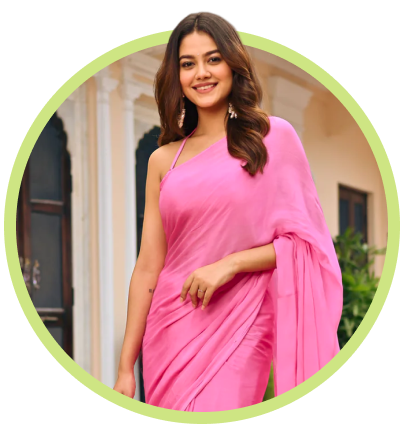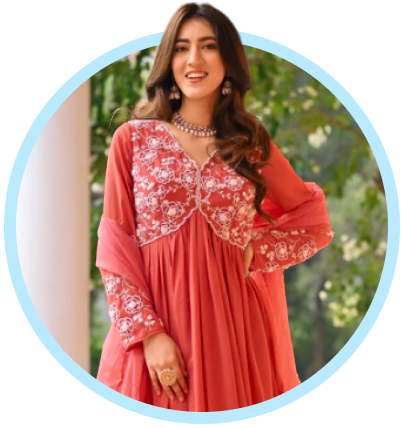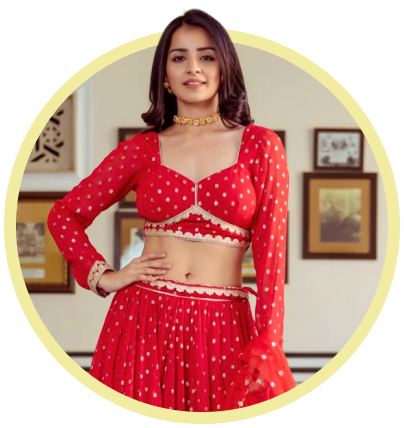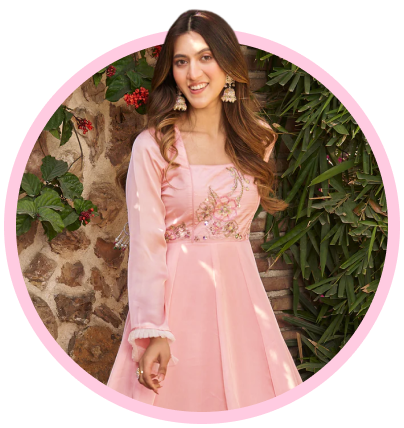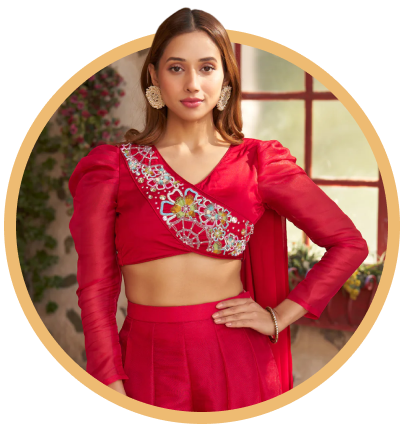
Indian ethnic wear for women is a broad fashion segment, including sarees, lehenga, and sharara and gharara suits. Each holds a special place and is regarded for its uniqueness, elegance, traditional charm, and versatility. Sharara and gharara are beautiful garments individually, but very few people truly understand the difference between the two. Their similar appearance can be easily confusing, but they are definitely not synonymous with each other. In women's fashion, many outfits have striking resemblances in terms of their designs and silhouette. However, if you dig deeper, you will learn about their distinct differences rooted in their design, history, and cultural significance. Let’s understand these iconic pieces of attire closely and explore their places in contemporary fashion.
Are Sharara and Gharara Suits Traditional?
When Indian ethnic wear is mentioned, we visualize 9-yard sarees, salwar suits, lehengas, and kurtis. You might be surprised to learn that an entire line of women's fashion exists dedicated primarily to the ethnic category. It is more vast than Western wear for women. Both sharara and gharara suits are integral to this fashion category for women. Both outfits have a very rich story to share, as each dates back to the royal era of our country.
The sharara finds its roots in the Mughal era, reflecting the opulence and grandeur of that time. They adorned the beautiful royal women back in the Mughal period, symbolizing their regal status. Over the years, sharara became a symbol of grace and elegance in Indian and Pakistani cultures. The garment offered comfort to royal queens and princesses and was deemed a fitting attire during times when air conditioning and ceiling fans were still a distant dream. Even today, this attire is opted for its grace ad comfort. That said, the sharara has evolved with modern designs and lighter fabrics, thus gaining a more suitable position in contemporary fashion.
The gharara was also a chosen outfit for the royals, but was not so popular alongside the sharara during the Mughal period. Instead, it became a signature outfit of Nawabi culture. Being originated in the Awadh region (modern-day Lucknow), the gharara is best-known for its structured design and luxurious fabrics, reflecting the sophistication and refinement of the Nawabs.
Today, both are being increasingly adapted in contemporary fashion to give a charming, royal twist to traditional outfits.
What is a Sharara Dress - A Brief Introduction
A sharara dress is a traditional outfit originating from the Mughal era. It consists of flared pants paired with a short or long kurta and a dupatta. The hallmark of sharara pants is their continuous flare that starts from the waist and flows gracefully to the bottom, giving a skirt-like appearance. The sharara features intricate embellishments on the fabric, highlighting the rich cultural heritage of the period they originated from.
The overall garment ensemble is uniquely distinct and can be easily paired with different tops to give a new aesthetic feel each time. To sum up the features of the sharara, the below-mentioned points are essential to consider:
- Flared Bottoms: The flare begins from the waist, creating a flowing silhouette.
- Versatility: It can be styled with short kurtis, peplum tops, or long anarkali-style kurtas.
- Fabrics: Georgette, silk, chiffon, and net are commonly used to make georgette sharara suits and other designs.
- Occasions: Sharara suits for women are ideal for weddings, festive occasions, and parties.
What is a Gharara Suit - A Brief Introduction
A gharara suit is a traditional attire primarily associated with Lucknowi culture. It consists of a pair of straight pants that flare out dramatically from the knees, creating a more structured and layered look. These pants are usually adorned with intricate embroidery or zari work at the knee joint, where the flare begins.
Here are the key features of gharara suits to remember:
- Knee Joint: The defining characteristic is the abrupt joint at the knees, highlighted with embellishments.
- Straight Upper Fit: The pants fit snugly from the waist to the knees before flaring out.
- Cultural Roots: Ghararas are deeply rooted in Nawabi traditions and are a staple for Muslim brides.
-
Styling: Gharara suits often include a short kurti and a heavily embroidered dupatta.
Evaluating the Traditional and Modern Styling of Sharara and Gharara
Traditional sharara suits are handcrafted with care, using rich and delicate fabrics like silk and brocade. They are adorned with zari, zardozi, and sequin work, reflecting the weaving finesse of our traditional outfits. These suits are typically paired with a heavily embellished dupatta, completing the royal look.
Contrarily, classic gharara suits boast intricate Lucknowi chikankari or heavy zari embroidery. The straight-fit kurti paired with the flared gharara pants creates a timeless look perfect for weddings and festive occasions.
Modern Adaptations
Today’s fashion landscape has seen innovative adaptations of both sharara and gharara styles:
- Sharara Suits with Short Kurtis: This style offers a youthful vibe, perfect for casual gatherings.
- Punjabi Sharara Suits: These combine the traditional sharara with Punjabi embroidery and patterns, adding a regional twist.
- Gharara Dresses for Weddings: Contemporary designs include pastel shades and minimalistic embellishments for modern brides.
Popular Designs and Styling Tips of Sharara and Gharara Suits
You will find yourself spoiled with choices from diverse designs of sharara and gharara suits. However, knowing the art of styling these outfits is a skill. Explore the designs and learn the styling tips to bring out the beauty of sharara and gharara in a unique, regal way.
Sharara Suit Designs
- Party Wear Sharara: Perfect for evening events with sequin or mirror work.
- Georgette Sharara Suit: Lightweight and flowy, ideal for summer weddings.
- Sharara with Peplum Top: A contemporary twist on the traditional outfit.
- Kurti Sharara: Simple yet elegant, suitable for semi-formal gatherings.
Styling Sharara Suits
- Dupatta Draping: Drape it over one shoulder for a modern look or both for a traditional vibe.
- Accessories: Pair with jhumkas and a maang tikka for a royal appearance.
- Footwear: Choose embellished juttis or heels to enhance the outfit’s elegance.
Gharara Suit Designs
- Traditional Gharara Designs: Featuring rich embroidery and zari work.
- Pastel Ghararas: Modern brides’ favourite for daytime weddings.
- Gharara with Long Kurti: A sophisticated choice for formal occasions.
- Gharara Dresses for Weddings: Heavy embellishments and vibrant colours.
Styling Gharara Suits
- Kurti Length: Opt for a short kurti to highlight the gharara’s intricate designs.
- Jewellery: Statement necklaces and earrings complement the regal style.
- Makeup: Keep it bold with kohl-rimmed eyes and a red or nude lip.
Sharara vs Gharara: Which One Should You Choose?
Your choice between a sharara and a gharara depends on the occasion, your personal style, and the look you want to achieve. Here are some suggestions:
Opt for a Sharara If:
- You prefer a flowing silhouette resembling a skirt.
- You want a versatile outfit for various occasions.
- You love experimenting with different patterns of sharara pants.
Opt for a Gharara If:
- You’re looking for a structured and regal outfit.
- You want to embrace traditional Nawabi styles.
- You need a statement piece for weddings or formal events.
Difference Between Sharara and Gharara - A Brief Snapshot
While both outfits are graceful and exude royal charm, their distinct features set them apart:
|
Aspect |
Sharara |
Gharara |
|
Pant Style |
Continuous flare from the waist to the bottom. |
Straight fit till the knees, with a dramatic flare starting at the knee. |
|
Joint Design |
No joint or partition in the pants. |
A noticeable joint at the knees, often adorned with embellishments. |
|
Silhouette |
Creates a skirt-like flowing silhouette. |
Offers a structured and layered look. |
|
Cultural Significance |
Associated with Mughal royalty. |
Rooted in Lucknowi Nawabi culture. |
|
Occasion |
Versatile for weddings, parties, and casual wear. |
Primarily worn for weddings and traditional ceremonies. |
Conclusion
Both sharara and gharara suits are timeless pieces of traditional attire that continue to captivate fashion enthusiasts. While the sharara offers a flowing and versatile silhouette, the gharara boasts a structured and regal charm. Understanding the difference between sharara and gharara helps in choosing the perfect outfit for any occasion, whether it’s a wedding, party, or festive celebration. Embrace these beautiful ensembles to make a statement while celebrating the rich heritage of Indian fashion.
For the latest designs in sharara and gharara suits, explore collections on platforms like Kreeva. Stay stylish and celebrate tradition with these iconic outfits!

